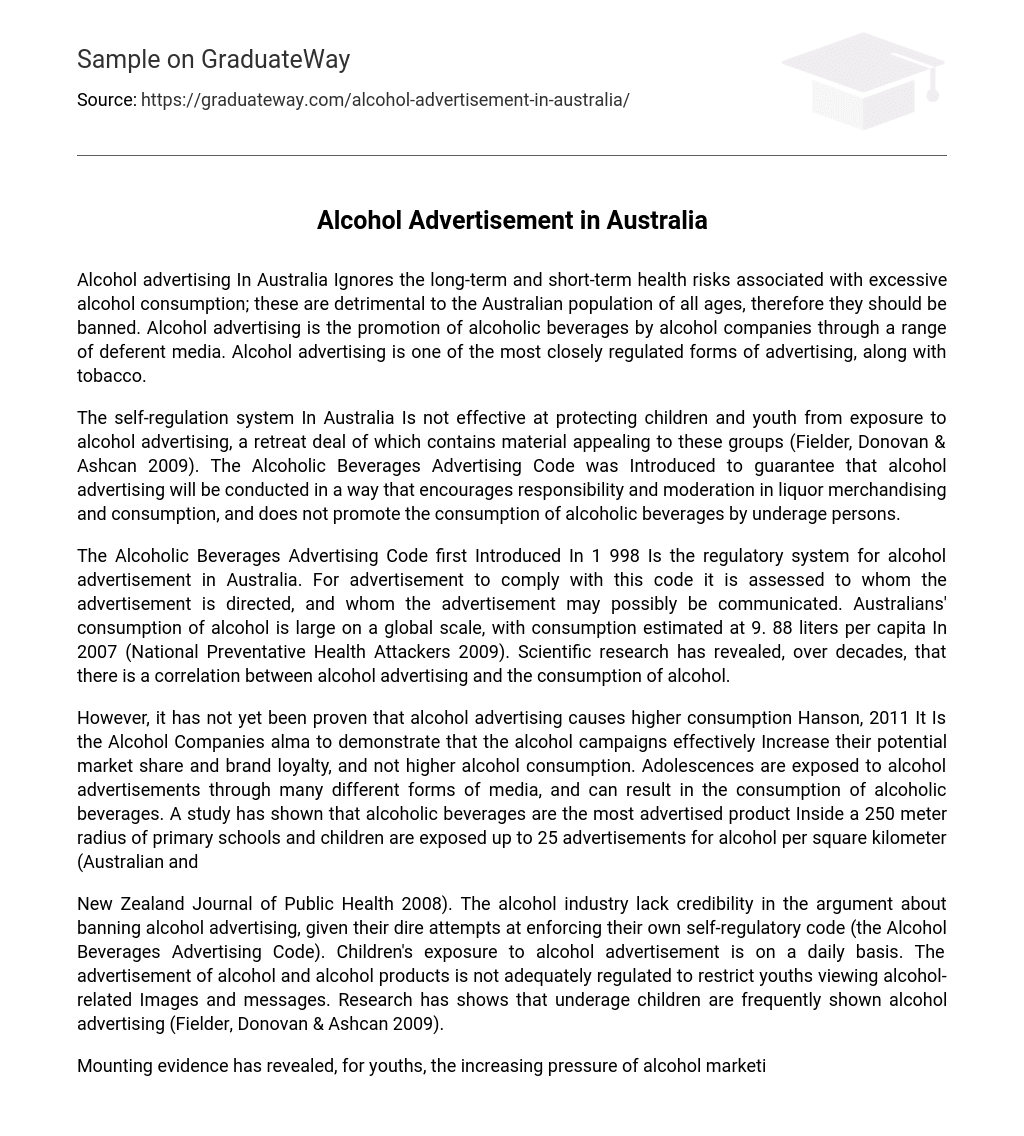Alcohol advertising In Australia Ignores the long-term and short-term health risks associated with excessive alcohol consumption; these are detrimental to the Australian population of all ages, therefore they should be banned. Alcohol advertising is the promotion of alcoholic beverages by alcohol companies through a range of deferent media. Alcohol advertising is one of the most closely regulated forms of advertising, along with tobacco.
The self-regulation system In Australia Is not effective at protecting children and youth from exposure to alcohol advertising, a retreat deal of which contains material appealing to these groups (Fielder, Donovan & Ashcan 2009). The Alcoholic Beverages Advertising Code was Introduced to guarantee that alcohol advertising will be conducted in a way that encourages responsibility and moderation in liquor merchandising and consumption, and does not promote the consumption of alcoholic beverages by underage persons.
The Alcoholic Beverages Advertising Code first Introduced In 1 998 Is the regulatory system for alcohol advertisement in Australia. For advertisement to comply with this code it is assessed to whom the advertisement is directed, and whom the advertisement may possibly be communicated. Australians’ consumption of alcohol is large on a global scale, with consumption estimated at 9. 88 liters per capita In 2007 (National Preventative Health Attackers 2009). Scientific research has revealed, over decades, that there is a correlation between alcohol advertising and the consumption of alcohol.
However, it has not yet been proven that alcohol advertising causes higher consumption Hanson, 2011 It Is the Alcohol Companies alma to demonstrate that the alcohol campaigns effectively Increase their potential market share and brand loyalty, and not higher alcohol consumption. Adolescences are exposed to alcohol advertisements through many different forms of media, and can result in the consumption of alcoholic beverages. A study has shown that alcoholic beverages are the most advertised product Inside a 250 meter radius of primary schools and children are exposed up to 25 advertisements for alcohol per square kilometer (Australian and
New Zealand Journal of Public Health 2008). The alcohol industry lack credibility in the argument about banning alcohol advertising, given their dire attempts at enforcing their own self-regulatory code (the Alcohol Beverages Advertising Code). Children’s exposure to alcohol advertisement is on a daily basis. The advertisement of alcohol and alcohol products is not adequately regulated to restrict youths viewing alcohol-related Images and messages. Research has shows that underage children are frequently shown alcohol advertising (Fielder, Donovan & Ashcan 2009).
Mounting evidence has revealed, for youths, the increasing pressure of alcohol marketing creates negative attitudes towards alcohol consumption, and significantly impacts their decision to drink, as well as how they drink (National Preventative Health Attackers 2009). Underage drinking can cause youth’s brains to be extremely damaged from alcohol. Large alcohol exposure to the developing youth’s brain can be 1 OFF memory difficulties that can arise from alcohol consumption.
Sections of the brain hat are affected by alcohol are directly correlated with memory and emotions, and binge drinking could produce memory problems, problems with verbal skills, incapacity to learn and depression. The existing regulatory system does not effectively regulate these exposures, and does not attempt to decrease or abolish the appeal of the advertising content. The 30 highest viewed alcohol advertisements to the underage population included at least one component identified to appeal to children and underage youth, with 23 found to contain two or more such material.
It was also found that 1 5 of the 30 advertisements contained an animal (Fielder, Donovan & Ashcan 2009). The self-regulation system in Australia fails to safe- guard children and youth from exposure to alcohol advertising, with a good majority containing elements appealing to youths. The advertising companies’ target audience of their advertising campaigns have changed, with various brands being targeted towards a particular population. Some drinks are typically seen as a masculine drink, predominantly beers and dark spirits, whilst wines and cocktails are seen as feminine.
Brands have said to be specifically produced to appeal to a population that would not generally drink that kind of alcoholic beverage. The alcohol industry has come under criticism and restricted legislation in their alleged targeting of young people, with the creation of alcoholic beverages that are sweet-tasting and bright colored which appeal to the younger population. However, there is no solid evidence that supports this alleged targeting of youths.
There have been wide spread debate on whether alcohol advertisements re targeting the teenage population, although alcohol advertisement makes consumption look extremely exciting and enjoyable with a majority of which involve parties. Exposure to alcohol advertisements is a daily occasion; they are on television, radio, billboards, concerts, magazines and sporting events. If alcohol advertising was to be banned there would be a certain objection from alcohol companies, outlets, sporting bodies and association. Alcohol is a major sponsor within Australian sports and is estimated to be worth $1. Billion a year. Large quantities of alcohol consumption are linked to severe public and social health problems involving violence, crime, road accidents and disease. With the taxing of premixed drinks there is intent to address the problem, however this has not made much of a difference, with adolescence moving onto different forms of alcohol. With the alcohol advertisement nearly everywhere and binge drinking within the teenage population still prevalent, the self-regulatory systems set up at present are not adequate.
Heavy alcohol consumption has become a part of Australian culture; advertisement is encouraging these trends, and should be banned.





